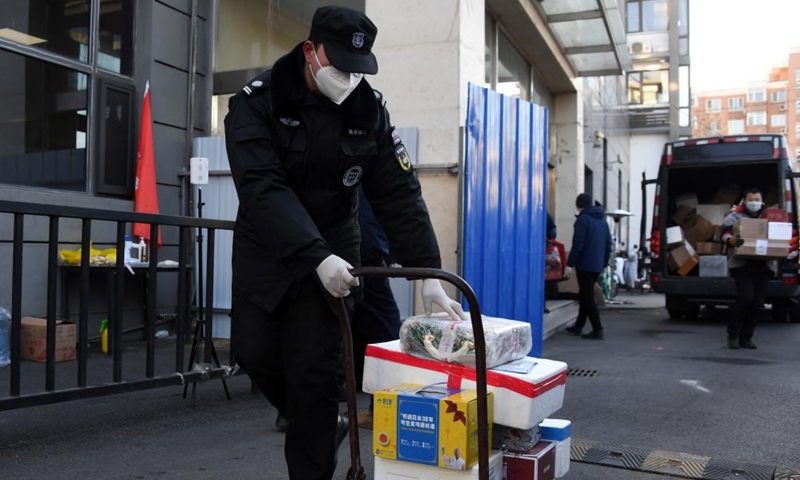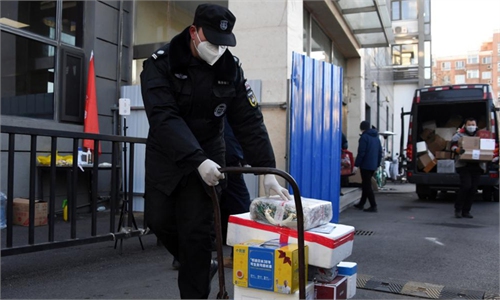
A community worker delivers daily necessities ordered by residents at a residential compound in Haidian District of Beijing, capital of China, Jan. 16, 2022.Photo:Xinhua
The single Omicron case detected in Beijing was traced back to an international document from Canada, and it was found to have similar strains from those in North America and Singapore. The Omicron variant was detected on the outer package, internal surface and papers of the mail, Beijing health authorities revealed on Monday.
The patient who was found with Omicron on Saturday had received an international mail on January 11 which was sent from Canada on January 7, transferred via the US and China's Hong Kong region to Beijing.
Combined with the epidemiological studies, the testing results of suspicious samples and the gene sequencing result of the case, the possibility that the Beijing case was infected by the virus through the international mail cannot be ruled out, Pang Xinghuo, deputy director of the Beijing center for disease control and prevention, said at Monday's press conference.
The Omicron strain of the patient in Beijing is similar to those of North America and Singapore in December 2021, Pang said. The Beijing health authorities ruled out the possibility that the case has any relation with Omicron-infected outbreaks in other Chinese cities.
The patient only had contact with the outer package of the document and the front page of the document inside the mail. She did not touch the internal surface of the mail or other papers.
Testing results on 22 samples relating to the mail showed Omicron was detected in two samples of the outer surface of the mail package, two samples of internal surface of the package as well as eight samples of the paper inside.
Eight people that were in connection with the mail were tracked. Their nucleic acid testing results were negative.
Other than that, another international mail that was from the same delivery route, which has yet to be opened, also tested positive for COVID-19 virus.
The risk of the infection being further spread in Beijing is small because, as Pang said, all hot spots that the patient went to in the past 14 days before she was confirmed tested negative. A total of 69 people were found as close contacts, and their testing results were also negative.
A total of 16,547 people that were deemed to be at risk were tested and their results came back negative.
Previously, China reported multiple outbreaks in relation to imported goods. The COVID-19 virus can survive for a long time in low temperature, thus the risk of goods causing the viral transmission increases in winter, Pang said, suggesting people reduce purchasing overseas commodities as the epidemic overseas is rampant.
The Beijing health authorities reminded people to take precautionary measures when receiving mail or goods from overseas by wearing masks and gloves and disinfecting and disposing of the packages properly.


